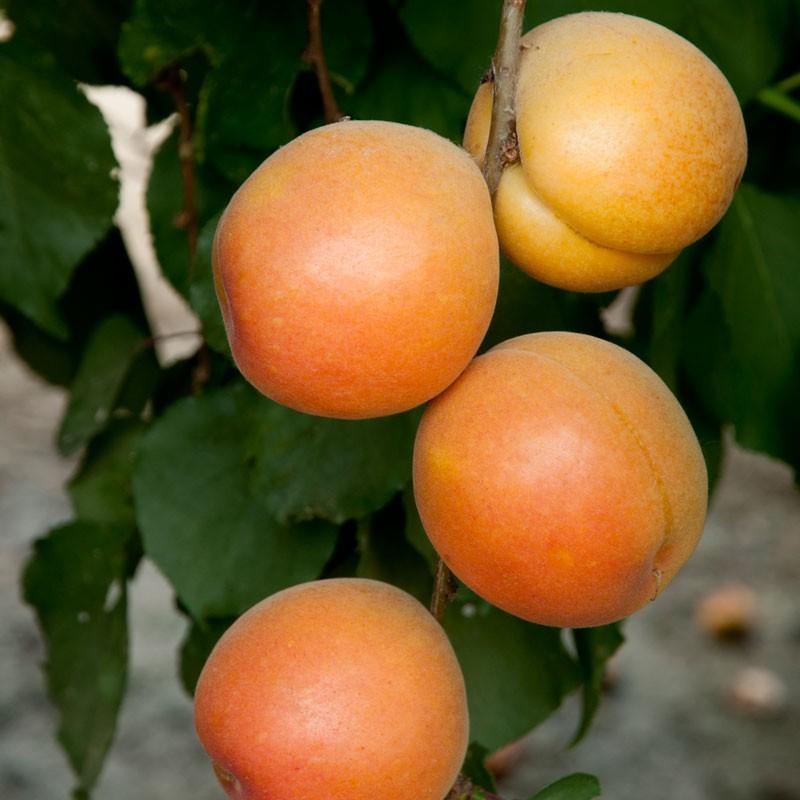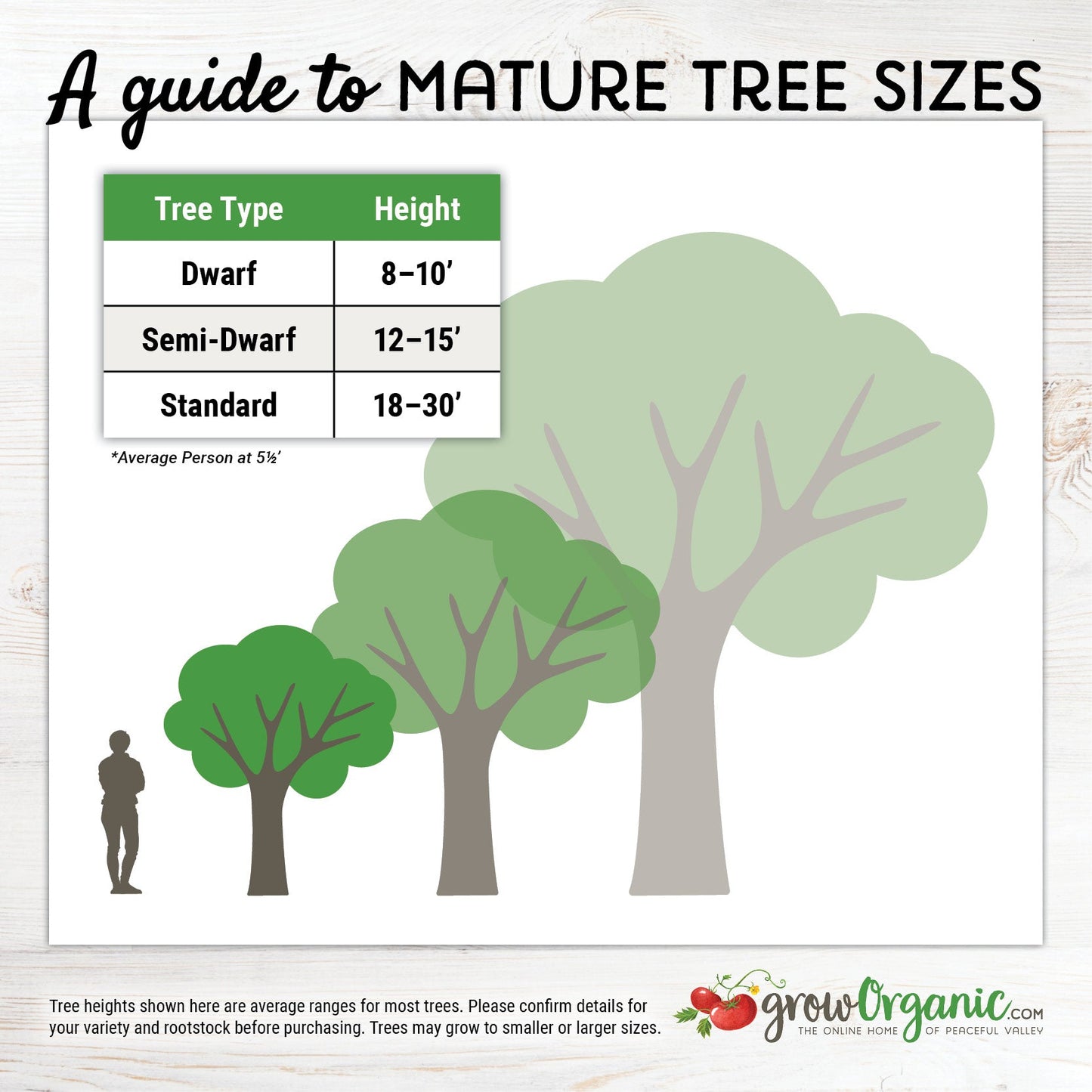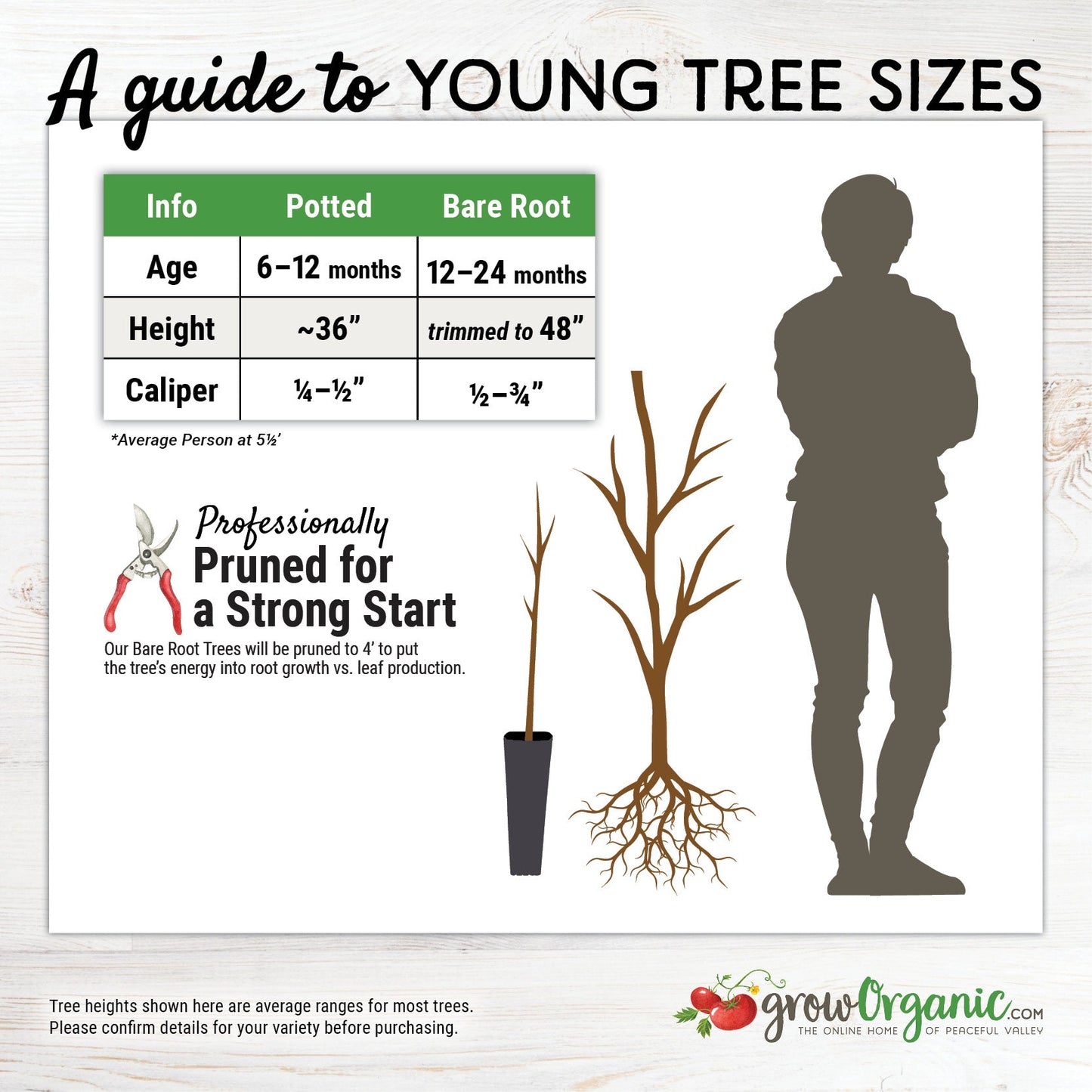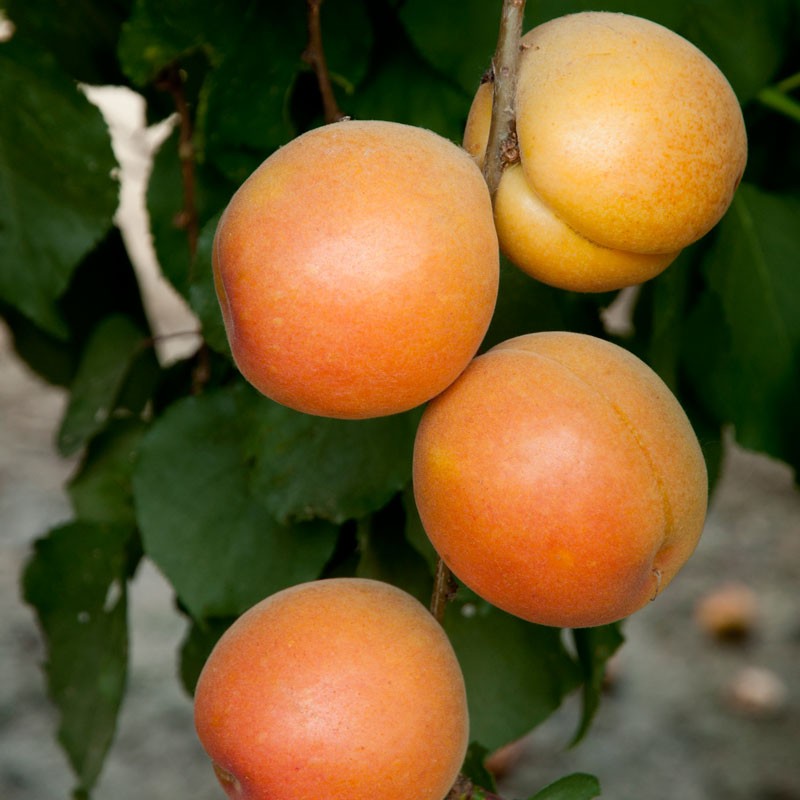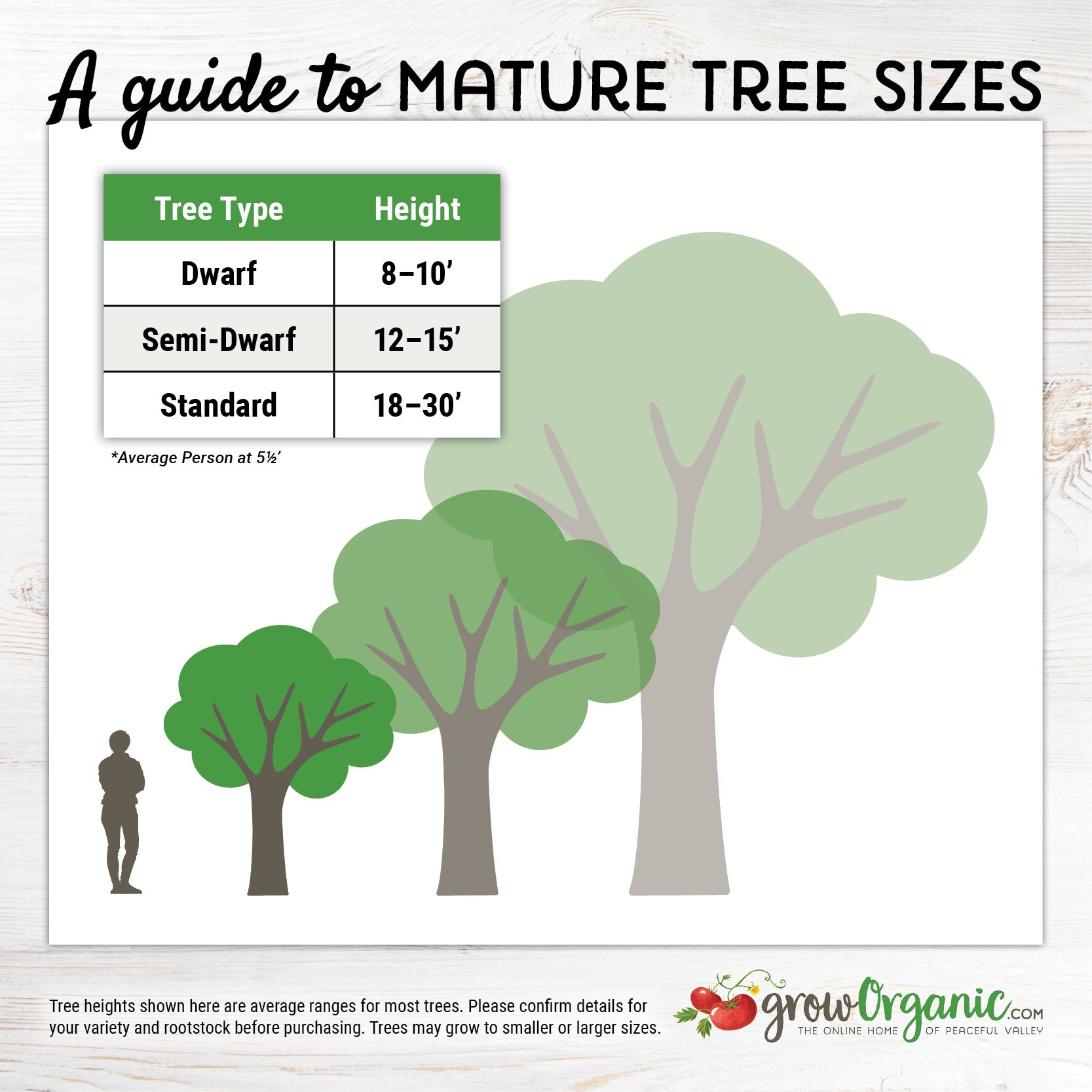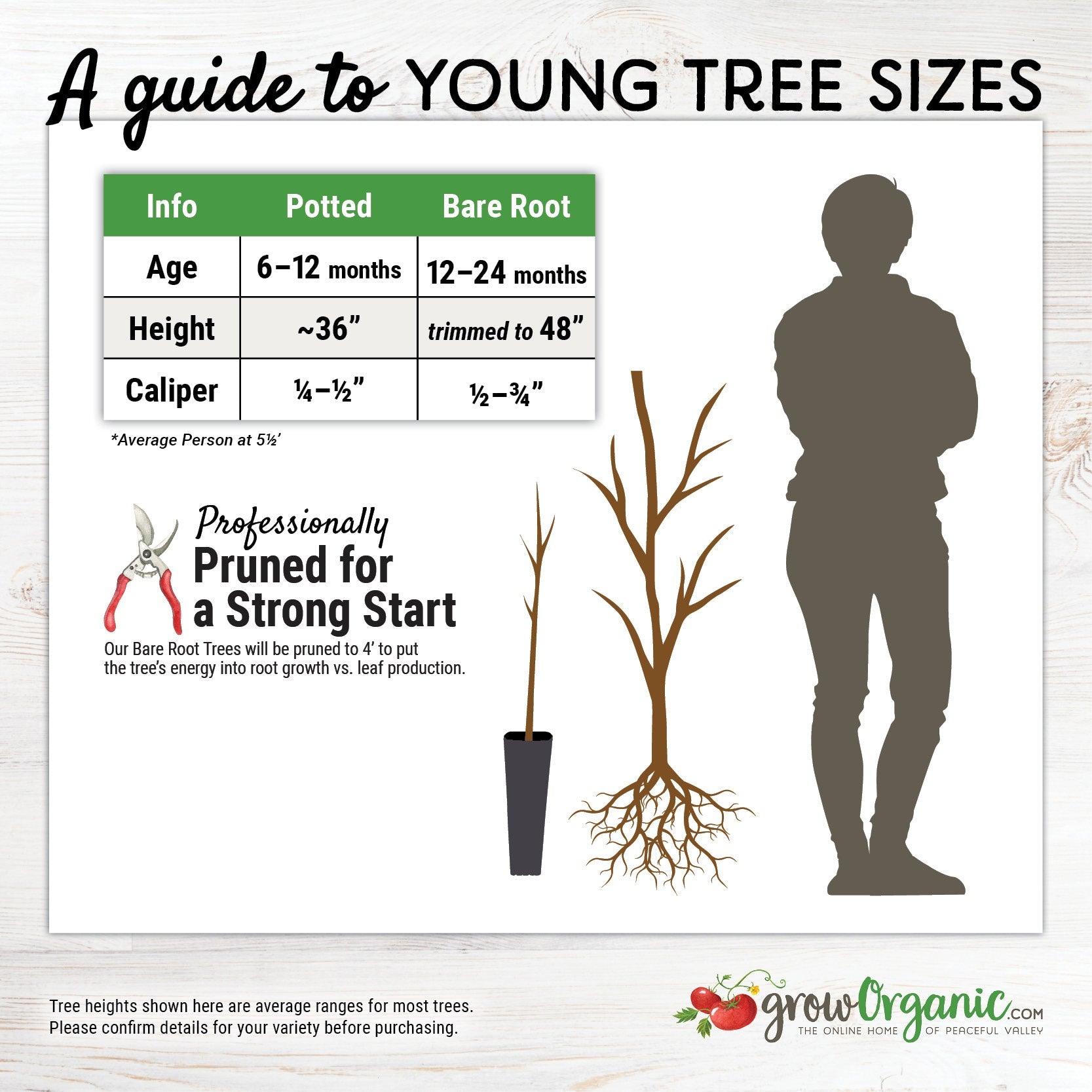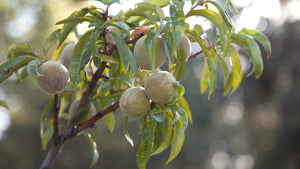Item Number: FT069
Katy Apricot Tree
Katy Apricot Tree
Early Harvest of Sweet Apricots
Semi-dwarf on Citation rootstock.
- Zones: 6-9
- Chill hours: 300-400
- Bloom Time: Early (Based on typical Central Valley California weather)
- Harvest: May 25 - June 5
- Looks: Golden-orange skin.
- Personality: Tree-ripened fruit is subacid (not tart).
- Facts of note: Large, all-purpose, flavorful freestone. Katy contains a lot of sugar, so it's delicious fresh and a great candidate for drying. Katy Apricot will be one variety worth considering if you live in an area with mild winters because it only needs 300 chill hours and is self fertile. This variety is a relatively early bloomer. Dependably set heavy crops year after year. Enjoy this all-purpose, flavorful sub-acid apricot fresh, or for cooking, canning, drying, freezing and jams and jellies.
- Pollination: Self-fruitful
The Katy Apricot Tree (Prunus armeniaca 'Katy') is a delightful addition to any home orchard. Known for its sweet and juicy apricots, this semi-dwarf fruit tree offers both beauty and bounty to your garden.
Introduction to the Katy Apricot Tree:
The Katy Apricot Tree is a deciduous fruit tree that belongs to the Rosaceae family. It is a compact or semi-dwarf variety, which makes it an excellent choice for smaller gardens, patios, or even large containers. This tree is prized for its luscious apricots, which are known for their sweet and tangy flavor.
Key Characteristics of the Katy Apricot Tree:
Size: The Katy Apricot Tree typically grows to a height of 8 to 12 feet, with a similar spread. Its compact size is perfect for limited garden space.
Fruit: The apricots produced by this tree are medium-sized, round, and have a beautiful orange color when ripe. They are sweet, juicy, and have a delightful blend of sweet and tart flavors.
Blossoms: In early spring, the Katy Apricot Tree adorns itself with a profusion of delicate pinkish-white blossoms, adding a stunning visual appeal to your garden.
Chilling Requirements: To set fruit properly, apricot trees like Katy require a certain amount of winter chill hours, typically between 400 to 600 hours of temperatures below 45°F (7°C).
Caring for Your Katy Apricot Tree:
Planting: Select a sunny location in your garden with well-draining soil. Ensure that the tree receives at least 6 hours of direct sunlight daily. Plant it in a hole that is twice as wide as the root ball and at the same depth.
Watering: Adequate and consistent watering is essential, especially during the tree's establishment phase. Provide deep watering to keep the soil consistently moist but not waterlogged.
Fertilization: Apply a balanced, slow-release fertilizer in the spring before new growth begins. Follow the recommended application rates on the product label.
Pruning: Pruning is essential to maintain the shape and size of your Katy Apricot Tree. Remove any dead, damaged, or diseased branches. Additionally, thinning the tree to improve air circulation and light penetration can help prevent disease.
Pest and Disease Management: Keep an eye out for common apricot pests like aphids and plum curculio. Regularly inspect the tree for signs of disease, such as brown rot. Applying appropriate organic remedies can help manage these issues.
Harvesting: Apricots are typically ready for harvest in early to mid-summer, depending on your local climate. Harvest the fruits when they are fully ripe but still firm. Gently twist the fruit from the tree or use pruning shears to avoid damaging the branches.
Benefits of Growing a Katy Apricot Tree:
Homegrown Apricots: Enjoy the pleasure of picking and savoring fresh, homegrown apricots. The fruits are perfect for eating fresh, drying, canning, or making jams and preserves.
Ornamental Value: The Katy Apricot Tree's beautiful blossoms in spring and lush green foliage in summer provide aesthetic appeal to your garden.
Space-Saving: This semi-dwarf apricot tree is an excellent choice for smaller gardens or for those who prefer to grow fruit trees in containers.
Nutritional Value: Apricots are a good source of vitamins A and C, dietary fiber, and various antioxidants. Including them in your diet can contribute to your overall health and well-being.
The Katy Apricot Tree combines the practicality of a space-saving, semi-dwarf tree with the pleasure of growing and enjoying your apricots. With proper care and attention, this tree can grace your garden with a bounty of sweet and flavorful apricots, adding both visual beauty and delectable taste to your outdoor space.
Visit our Fruit Tree Central for a listing of all our fruit tree videos and articles.
Visit Tree Characteristics for a listing of all our fruit & nut tree growing characteristics.


Check Your Zone Compatibility:
Compatible with your zone.
Growing Zone for
,

Our Guarantee To You
Since 1976, we've served our customers at every stage of growing. Please contact us at any time. We are happy to support and assist you.
Description
Description
Semi-dwarf on Citation rootstock.
- Zones: 6-9
- Chill hours: 300-400
- Bloom Time: Early (Based on typical Central Valley California weather)
- Harvest: May 25 - June 5
- Looks: Golden-orange skin.
- Personality: Tree-ripened fruit is subacid (not tart).
- Facts of note: Large, all-purpose, flavorful freestone. Katy contains a lot of sugar, so it's delicious fresh and a great candidate for drying. Katy Apricot will be one variety worth considering if you live in an area with mild winters because it only needs 300 chill hours and is self fertile. This variety is a relatively early bloomer. Dependably set heavy crops year after year. Enjoy this all-purpose, flavorful sub-acid apricot fresh, or for cooking, canning, drying, freezing and jams and jellies.
- Pollination: Self-fruitful
The Katy Apricot Tree (Prunus armeniaca 'Katy') is a delightful addition to any home orchard. Known for its sweet and juicy apricots, this semi-dwarf fruit tree offers both beauty and bounty to your garden.
Introduction to the Katy Apricot Tree:
The Katy Apricot Tree is a deciduous fruit tree that belongs to the Rosaceae family. It is a compact or semi-dwarf variety, which makes it an excellent choice for smaller gardens, patios, or even large containers. This tree is prized for its luscious apricots, which are known for their sweet and tangy flavor.
Key Characteristics of the Katy Apricot Tree:
Size: The Katy Apricot Tree typically grows to a height of 8 to 12 feet, with a similar spread. Its compact size is perfect for limited garden space.
Fruit: The apricots produced by this tree are medium-sized, round, and have a beautiful orange color when ripe. They are sweet, juicy, and have a delightful blend of sweet and tart flavors.
Blossoms: In early spring, the Katy Apricot Tree adorns itself with a profusion of delicate pinkish-white blossoms, adding a stunning visual appeal to your garden.
Chilling Requirements: To set fruit properly, apricot trees like Katy require a certain amount of winter chill hours, typically between 400 to 600 hours of temperatures below 45°F (7°C).
Caring for Your Katy Apricot Tree:
Planting: Select a sunny location in your garden with well-draining soil. Ensure that the tree receives at least 6 hours of direct sunlight daily. Plant it in a hole that is twice as wide as the root ball and at the same depth.
Watering: Adequate and consistent watering is essential, especially during the tree's establishment phase. Provide deep watering to keep the soil consistently moist but not waterlogged.
Fertilization: Apply a balanced, slow-release fertilizer in the spring before new growth begins. Follow the recommended application rates on the product label.
Pruning: Pruning is essential to maintain the shape and size of your Katy Apricot Tree. Remove any dead, damaged, or diseased branches. Additionally, thinning the tree to improve air circulation and light penetration can help prevent disease.
Pest and Disease Management: Keep an eye out for common apricot pests like aphids and plum curculio. Regularly inspect the tree for signs of disease, such as brown rot. Applying appropriate organic remedies can help manage these issues.
Harvesting: Apricots are typically ready for harvest in early to mid-summer, depending on your local climate. Harvest the fruits when they are fully ripe but still firm. Gently twist the fruit from the tree or use pruning shears to avoid damaging the branches.
Benefits of Growing a Katy Apricot Tree:
Homegrown Apricots: Enjoy the pleasure of picking and savoring fresh, homegrown apricots. The fruits are perfect for eating fresh, drying, canning, or making jams and preserves.
Ornamental Value: The Katy Apricot Tree's beautiful blossoms in spring and lush green foliage in summer provide aesthetic appeal to your garden.
Space-Saving: This semi-dwarf apricot tree is an excellent choice for smaller gardens or for those who prefer to grow fruit trees in containers.
Nutritional Value: Apricots are a good source of vitamins A and C, dietary fiber, and various antioxidants. Including them in your diet can contribute to your overall health and well-being.
The Katy Apricot Tree combines the practicality of a space-saving, semi-dwarf tree with the pleasure of growing and enjoying your apricots. With proper care and attention, this tree can grace your garden with a bounty of sweet and flavorful apricots, adding both visual beauty and delectable taste to your outdoor space.
Visit our Fruit Tree Central for a listing of all our fruit tree videos and articles.
Visit Tree Characteristics for a listing of all our fruit & nut tree growing characteristics.
About Apricots: Blooms very early; generally difficult to grow, especially in late frost areas. Needs well-drained, moderately fertile soil. Thin fruit early in season to maximize size and quality. Susceptible to bacterial canker, shot hole fungus, brown rot and peach twig borer. Browse all our apricot trees for sale.
Please Note: Although most of our bare-root trees arrive to our warehouse in mid-December, there are a few varieties that will not arrive until mid-January. If you order any of those varieties along with varieties that arrive in mid-December, your order will be delayed for shipment until mid-January. If you'd like us to split your shipments, please contact us at (888) 784-1722 or orderdesk@groworganic.com. Additional shipping charges will apply.
Shipping Information
Shipping Information
Cannot ship to the following states: HI, AK, PR, GU, VI
Cannot ship via USPS.
Cannot ship via SmartPost.
Shipping Weight: 5.0 lb
Dimensions: 55.5"L x 7.3"W x 2.75"H
Features
Features
- Flavor Pick
- Freestone
- Self-fruitful
Characteristics
Characteristics
Planting & Care
Planting & Care
Useful Information
Useful Information
Guarantee
Guarantee
Limited Dormant Tree & Plant Guarantee
* Claim deadline is June 15th
We guarantee that your dormant tree or plant will arrive in good, viable condition. If your tree arrives in substandard condition, notify us within 3 days of delivery. Please email pictures of the box, inside packaging, the tree and its roots to helpdesk@groworganic.com. We will investigate your claim and process a request to exchange or refund the damaged product.
If your dormant tree or plant has not grown new leaves by June 15th, you may be eligible for our Limited Dormant Tree & Plant Guarantee. This guarantee provides for a store credit for the purchase price of the tree, excluding shipping. Please see the Instructions below.
Important Dates:
- April 1st Dormant trees/plants must be planted in the ground
- May 15th Perform scratch test, if no new leaves have grown
- June 15th Deadline to apply for a dormant tree/plant credit
All required documentation must be received by June 15th for your claim to be considered. Claims or documentation received after June 15th will be denied, without exception. Instructions listed below
Terms and Conditions
We cannot guarantee that your tree or plant will remain alive and healthy after it is received, or bear fruit as there are too many variables in your environment that are beyond our control (i.e. soil preparation, weed and pest control, proper irrigation, chill hours, compatible hardiness for your growing zone, proper choice of pollinator, extreme weather, rodent damage, disease, etc.).
We cannot guarantee that we will be able to provide a replacement tree/plant of the same species either that same growing season or in future years. Customers are responsible for all shipping fees associated with replacement trees and plants.
If we determine that the tree you purchased directly from us is not viable, we will issue you a store credit (not a refund) for the purchase price of the affected dormant tree or plant. Shipping is not included in the dormant tree/plant guarantee. Store credits can be used to purchase any product we sell and are valid for use only until July 1st of the following year.
Historically, 98% of our dormant trees and plants grow and thrive when they have been cared for and planted using our growing guides. Dormant trees and plants must be planted in the ground by April 1st in order to be eligible for credit. If the ground in your area is still frozen solid, you may temporarily plant your tree or plant in a pot.
Potted, non-dormant trees or plants are excluded from this guarantee as they are not dormant at the time of shipment. Evergreen trees such as citrus, avocado and olive trees are not available for credit under the Dormant Tree and Plant Guarantee.
Instructions
We guarantee that your dormant fruit tree or plant will leaf out, if you care for it according to our growing guides. In the unlikely event that your dormant tree or plant does not have leaves by May 15th, follow these simple steps to apply for a store credit:
Before you call or email, please perform a “scratch test” to determine if the tree or plant is still alive. This video shows how to check for live tissue under the bark. Scratch tests need to be done a few inches above and below the graft.
Green Cambium Layer / Living Trees
If the cambium layer under the bark is green, give your tree a little more time. It is still alive, but hasn’t come out of dormancy yet. Check to make sure that it is getting the right amount of deep root water, enough sunlight and that the weather is warm enough for that type of tree/plant to come out of dormancy. Every tree has its own personality and will come out of dormancy at different times. Be sure to submit the required documentation listed below by June 15th, if it doesn’t grow leaves.
Brown Cambium Layer / Dead Trees
If the scratch test shows a brown cambium layer or if your dormant tree/plant doesn’t have leaves by June 1st, please email us at helpdesk@groworganic.com. All required documentation listed below must be received by June 15th for your claim to be considered. To be considered for the guarantee claim, all required documentation must be received by June 15th. Incomplete submissions will be denied.
Required Documentation
- Order number
- Name of dormant tree/plant and the quantity affected
- Photos of each tree or plant showing:
- The roots (tree or plant must be pulled out of the ground)
- The scratch test areas
- The entire tree/plant
We reserve the right to not issue credit for items that have already been replaced. We also reserve the right to require photographic evidence that the tree/plant was not killed by root rot, rodent or mechanical damage.
Share
